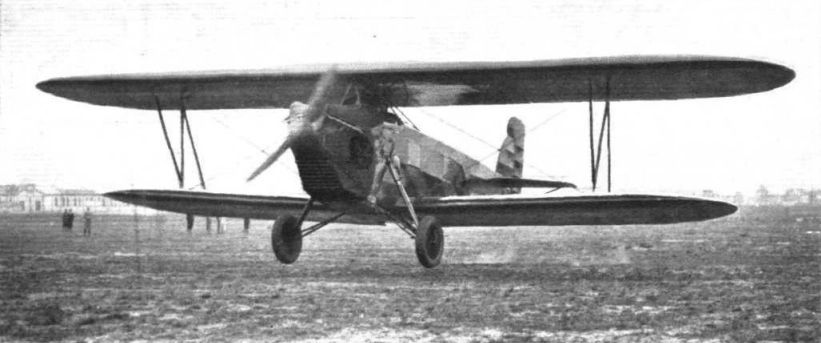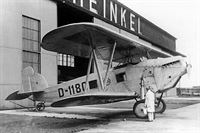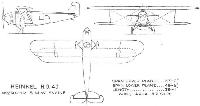Heinkel: бипланы серий HD 25/26/27/34/39/40/42/44
<...>
Машины HD 27, HD 39, HD 40 и HD 44 - серия коммерческих транспортных самолетов. Спроектированный компанией "Heinkel" в инициативном порядке, одноместный HD 27 с двумя отсеками для почты в носовой части фюзеляжа построен в Швеции фирмой "Svenska Aero AB". В 1925 году издательство "Ullstein AG" заказало модернизированный вариант самолета HD 27 с фюзеляжем увеличенного объема для скоростной доставки газет. На самолет установили мотор Liberty мощностью 400 л.с. (298 кВт). Несколько больший вариант HD 39 с мотором BMW IV мощностью 230 л.с. (172 кВт) поставили издательству "Ullstein" в мае 1926 года. В следующем году компания "Heinkel" построила еще больший по размерам HD 40, в задней кабине которого помещалось до шести пассажиров. Самолет HD 44 похож на HD 40, но он получил новое хвостовое оперение. Изначально на самолете стоял мотор BMW VI мощностью 600 л.с. (447 кВт), но в дальнейшем на этой машине испытывали двигатели разного типа. На самолете было установлено двойное управление.
<...>
ТАКТИКО-ТЕХНИЧЕСКИЕ ХАРАКТЕРИСТИКИ
Heinkel HD 39
Тип: легкий транспортный самолет
Силовая установка: один мотор жидкостного охлаждения BMW IV мощностью 230 л. с. (172 кВт)
Летные характеристики: максимальная скорость 165 км/ч; практический потолок 3810 м; дальность полета 850 км
Масса: пустого 1320 кг; максимальная взлетная 3850 кг
Размеры: размах крыла 14,80 м; длина 10,55 м; площадь крыльев 52,30 м2
Показать полностьюShow all
Flight, November 1927
A GERMAN NEWSPAPER CARRIER
The Heinkel H.D. 40
THE chief of the Heinkel Aircraft Works, Ltd., of Warnemunde, Dr. Ernst Heinkel, is one of the pioneers of German aviation, having been actively engaged upon aircraft design and or construction since the early days of aviation. In recent years, Dr. Heinkel has been rather less in the public eye, but has nevertheless been working along quietly and steadily. He has produced several aircraft types of late, and the machine which forms the subject of the following descriptive notes is the latest of which particulars have become available. The new Heinkel biplane, known as the type H.D.40, was specially designed to carry newspapers, and a fairly high cruising speed was desired (about 100 m.p.h), but a very simple alteration enables the machine to be converted into a passenger carrier. Apart from its technical features, the Heinkel is mainly of interest on account of the fact that it is fitted with one of the new B.M.W, engines, of 500-600 h.p., and is thus one of the most powerful single-engined German civil machines of recent years.
The Heinkel H.D. 40 is a development of, and somewhat larger, as well as more powerful than, the Heinkel H.D.39, which was also a newspaper carrier designed for the famous publishing firm of Ullstein, of Berlin. Whereas the H.D.39 was equipped with the B.M.W. IV, the H.D.40 is, as already stated, fitted with the B.M.W. VI engine. Aerodynamically the new machine is a fairly normal biplane, with but a single pair of struts on each side. Constructionally, it is of the mixed type, in that the fuselage is of welded steel tube construction, while the wings are of all-wood construction with three-ply covering. Light metal is used for lightly-stressed or non-stressed parts only.
The flat-sided fuselage is of welded steel tube construction, with four tubular longerons, to which are welded the vertical and horizontal struts, the bracing being by wire in the rear portion, and by diagonal welded-in tubes in front, where local considerations demand the more rigid arrangement. Covering is by fabric, except in the nose and neighbourhood of the pilot's cockpit, where aluminium is used. The fabric is so attached by lacing that it can be readily removed for purposes of inspecting the fuselage structure. The engine support is in the form of a steel tube unit, attached to the fuselage proper by four bolts only. The fuselage itself terminates in front in a fireproof bulkhead, and it is to the four corners of this that the engine unit is bolted.
The pilot's cockpit is under the top plane, and contains two seats placed side by side. Access to the cockpit is through a door in the side of the fuselage, and the usual instrument board is provided. In addition, the cockpit is equipped with dual controls, as well as with the duplicate mechanism for discharging the newspapers, this being so arranged that it can be operated either by the pilot or by the engineer. The cargo space for the newspapers is situated underneath the cockpit, and measures 1-2 x 1-4 x 1-0 m. (3 ft. 9 in. x 4 ft. 7 in. x 3 ft. 4 in.). If it is desired to use the H.D.40 as a passenger machine, the newspaper space can be used for luggage, the release mechanism being, of course, then removed. Behind the cockpit and newspaper space is the cabin proper, which may be used for carrying more newspapers, or, by fitting seats, it can be turned into passenger accommodation (6 to 8 seats). This space measures 1-8 x 1-2 x 3-0 m. (5 ft. 10 in. x 3 ft. 9 in. x 9 ft. 9 in.). In each side of the fuselage there is a door giving access to the cabin. The fittings for wings, undercarriage and tail are welded to the fuselage structure.
As already mentioned, the wings are of wood construction, even to the covering, which is in the form of ply-wood on the underside. The wings, which are in two sections, of which those of the top plane attach to a cabane, those of the lower plane to the fuselage, are very heavily staggered, and it will be observed that the rear spar of the top plane is immediately above the front spar, bringing the diagonal member of the "N" struts vertical in side elevation. The wing-bracing consists of streamline wires, the single set used lying in the plane of the diagonal member of the "N"-struts, the latter being counted upon to resist torsion. The wing section used is one developed by the Heinkel works in the wind tunnel, but no particulars of it are available.
The tail surfaces are of welded steel tube construction, fabric covered, and both the elevator and the rudder have horn balances. The tail plane can be trimmed during flight, while the vertical fin is adjustable on the ground.
The undercarriage is of the type in which there is no axle, the two Vees being hinged to the fuselage, and carrying, at their lower ends, the short stub axles, while the telescopic member runs to the top longeron. The shock is absorbed by rubber.
Mounted on the detachable engine bearer is a B.M.W. VI engine, the radiator being built into the fuselage covering below the engine. A water tank is placed inside the engine cowling, as is also the oil tank, which, like the petrol tank, is of sheet brass. The petrol tank is housed in the top plane, so that the feed to the engine is direct by gravity. The fuel capacity, by the way, is sufficient for 4 hours.
Following are the main characteristics of the Heinkel H.D.40 newspaper-carrier: Length overall 11-9 m. (39 ft 1 in.); span of top plane, 17-6 m. (57 ft. 9 in.); bottom plane, 15-15 m. (49 ft. 8 in.); wing area, 75-4 sq. m. (812 sq. ft.). Weight of machine empty, 2,107 kg. (4,635 lbs.); useful load 1.600 kg. (3,522 lbs.), consisting of: Crew of two, 160 kg. (355 lbs.); fuel for 4 hours, 440 kg. (967 lb.); paying load (newspapers), 1,000 kg. (2,200 lbs.). Total loaded weight, 3,707 kg. (8,157 lbs.). Ratio of useful load to empty weight 0-76; wing loading, 49-2 kg./sq. m. (10 lbs./sq. ft.). Power loading 7-95 kg./h.p. (17-5 lbs./h.p.), based on nominal power. "Wing power": 6-17 h.p. per sq. m. Top speed, 180 km./h. (112 m.p.h.). Landing speed, 75 km./h. (46-6 m.p.h.). Climb to 1,000 m. (3,280 ft.) in 8 minutes.
Показать полностьюShow all






